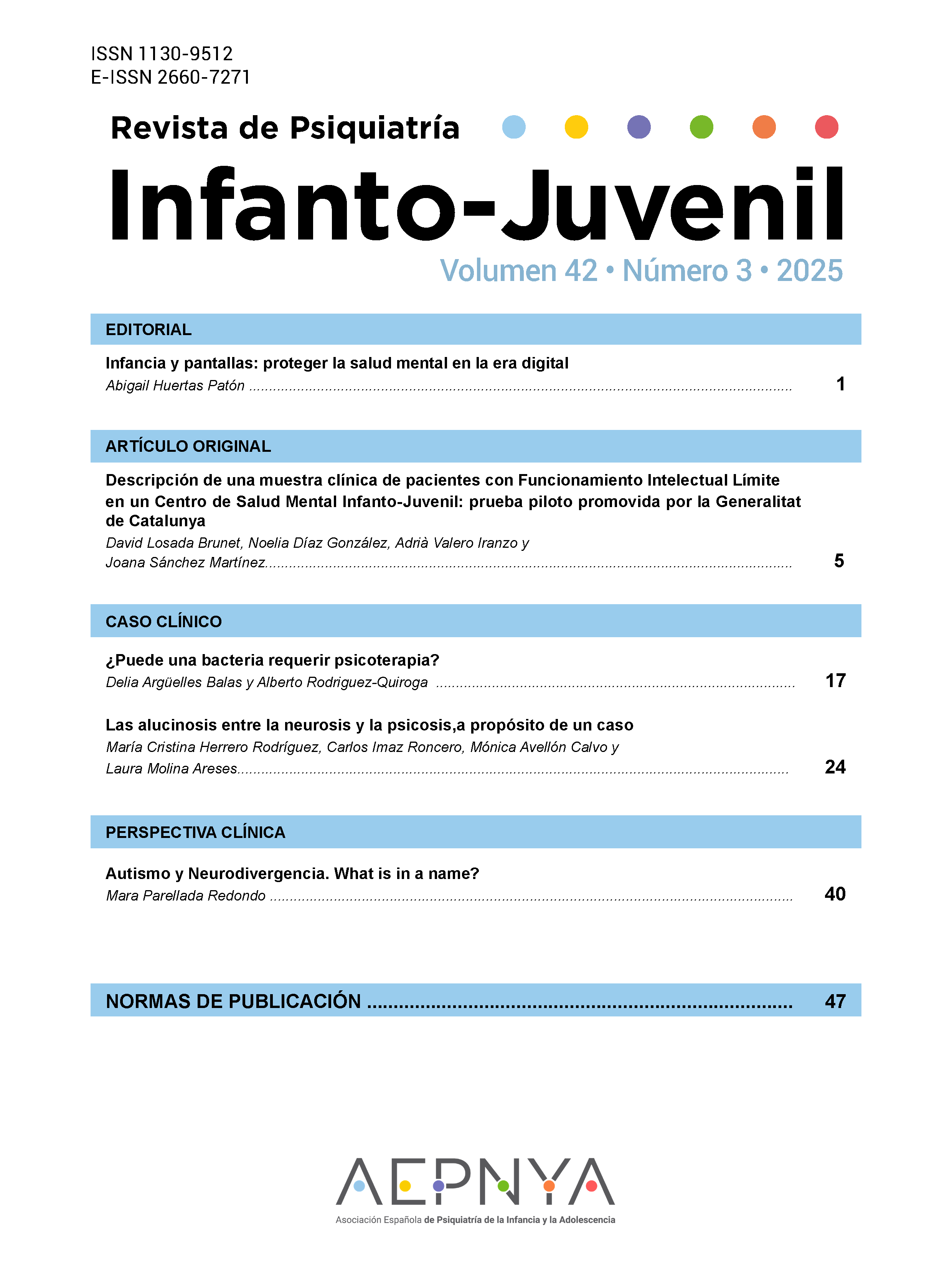Las alucinosis entre la neurosis y la psicosis, a propósito de un caso
Publicado
Cómo citar
Número
Sección
Licencia
Derechos de autor 2025 Revista de Psiquiatría Infanto-Juvenil

Esta obra está bajo una licencia internacional Creative Commons Atribución-NoComercial-SinDerivadas 4.0.
DOI:
https://doi.org/10.31766/revpsij.v42n3a4Palabras clave:
psicosis, neurosis, alucinosis, traumaResumen
Introducción: El desarrollo emocional durante la infancia y la adolescencia está determinado por varios factores, constituyendo una etapa crítica en el desarrollo personal y social. En este periodo pueden aparecer alteraciones de la percepción como las alucinosis. Son relativamente frecuentes y transitorias, por lo que su diagnóstico orienta hacia un proceso no psicótico, aunque tradicionalmente se ha vinculado al trastorno mental grave. Descripción del caso clínico: Se presenta el caso clínico de un varón que a los 15 años presenta alucinosis auditivas, sintomatología depresiva, ansiedad elevada y vivencias traumáticas con ingresos en Psiquiatría Infanto-Juvenil. La sintomatología del paciente ha fluctuado, alcanzando periodos de estabilidad, siendo crucial realizar un adecuado diagnóstico diferencial ya que las alucinosis auditivas pueden estar presentes en cuadros orgánicos, trastornos afectivos, trastornos adaptativos, trastornos de la personalidad, trastornos de la conducta alimentaria, trastornos obsesivos-compulsivos (TOC), trastornos disociativos, trastorno de estrés postraumático y trastornos psicóticos como las psicosis de inicio temprano (PIT) o experiencias psicóticas similares (psychotic-like experiences, PLEs). En nuestro caso, el contacto y la evolución no orientan hacia una estructura psicótica franca, sino que existen síntomas afectivos, obsesivos, disociativos o traumáticos y, en ocasiones de carácter psicótico. Discusión y conclusiones: La edad del paciente, su evolución y el tratamiento serán claves para aclarar el posible progreso hacia cronicidad o patología psicótica.
Descargas
Citas
Gilleland J, Suveg C, Jacob ML, Thomassin K. Understanding the medically unexplained: emotional and familial influences on children's somatic functioning. Child Care Health Dev. 2009 May; 35(3): 383-90. https://doi.org/10.1111/j.1365-2214.2009.00950.x DOI: https://doi.org/10.1111/j.1365-2214.2009.00950.x
Maijer K, Hayward M, Fernyhough C, Calkins ME, Debbané M, Jardri R, Kelleher I, Raballo A, Rammou A, Scott JG, Shinn AK, Steenhuis LA, Wolf DH, Bartels-Velthuis AA. Hallucinations in Children and Adolescents: An Updated Review and Practical Recommendations for Clinicians. Schizophr Bull. 2019 Feb 1;45(Suppl 1): S5-S23. https://doi.org/10.1093/schbul/sby119 DOI: https://doi.org/10.1093/schbul/sby119
Casey PR, Kelly B. Fish’s clinical psychopathology: signs and symptoms in psychiatry. 3rd ed. London: Royal College of Psychiatrists; 2007.
Garakani A. Commentary: Diagnostic Challenges. J Psychiatr Pract. 2022 May 1;28(3):270-271. https://doi.org/10.1097/PRA.0000000000000630 DOI: https://doi.org/10.1097/PRA.0000000000000630
Reimherr JP, McClellan JM. Diagnostic challenges in children and adolescents with psychotic disorders. J Clin Psychiatry. 2004;65(Suppl 6): 5-11. https://pubmed.ncbi.nlm.nih.gov/15104521/
Jardri R, Bartels-Velthuis AA, Debbané M, Jenner JA, Kelleher I, Dauvilliers Y, Plazzi G, Demeulemeester M, David CN, Rapoport J, Dobbelaere D, Escher S, Fernyhough C. From phenomenology to neurophysiological understanding of hallucinations in children and adolescents. Schizophr Bull. 2014 Jul;40 Suppl 4(Suppl 4): S221-32. https://doi.org/10.1093/schbul/sbu029 DOI: https://doi.org/10.1093/schbul/sbu029
Kelleher I, Cannon M. Psychotic-like experiences in the general population: characterizing a high-risk group for psychosis. Psychol Med. 2011 Jan;41(1): 1-6. https://doi.org/10.1017/S0033291710001005 DOI: https://doi.org/10.1017/S0033291710001005
Thakur T, Gupta V. Auditory Hallucinations. 2023 Feb 13. In: StatPearls [Internet]. Treasure Island (FL): StatPearls Publishing; 2025 Jan.
Longden E, Madill A, Waterman MG. Dissociation, trauma, and the role of lived experience: toward a new conceptualization of voice hearing. Psychol Bull. 2012 Jan;138(1): 28-76. https://doi.org/10.1037/a0025995 DOI: https://doi.org/10.1037/a0025995
So SH, Begemann MJ, Gong X, Sommer IE. Relationship between neuroticism, childhood trauma and cognitive-affective responses to auditory verbal hallucinations. Sci Rep. 2016 Oct 4;6: 34401. https://doi.org/10.1038/srep34401 DOI: https://doi.org/10.1038/srep34401
Edelsohn GA. Hallucinations in children and adolescents: considerations in the emergency setting. Am J Psychiatry. 2006 May;163(5): 781-5. https://doi.org/10.1176/ajp.2006.163.5.781 DOI: https://doi.org/10.1176/ajp.2006.163.5.781
Perona-Garcelan S, Garcia-Montes JM, Cuevas-Yust C, Perez-Alvarez M, Ductor-Recuerda MJ, Salas-Azcona R, Gomez-Gomez MT. A preliminary exploration of trauma, dissociation, and positive psychotic symptoms in a Spanish sample. J Trauma Dissociation. 2010;11(3): 284-92. https://doi.org/10.1080/15299731003786462 DOI: https://doi.org/10.1080/15299731003786462
Martín Gutiérrez R, González B. Las psicosis de inicio temprano: una revisión. Revista de Psiquiatría Infanto-Juvenil. 2016;33(4): 458-68. https://doi.org/10.31766/revpsij.v33n4a2 DOI: https://doi.org/10.31766/revpsij.v33n4a2
Camerini BA, Baker KK, Gadelha A, Margolis RL. Hearing Voices and Seeing Things: Symptoms of Anxiety Misconstrued as Evidence of Schizophrenia in an Adolescent. J Psychiatr Pract. 2021 May 5;27(3): 232-8. https://doi.org/10.1097/PRA.0000000000000547 DOI: https://doi.org/10.1097/PRA.0000000000000547
Hinterbuchinger B, Mossaheb N. Psychotic-Like Experiences: A Challenge in Definition and Assessment. Front Psychiatry. 2021 Mar 29;12: 582392. https://doi.org/10.3389/fpsyt.2021.582392 DOI: https://doi.org/10.3389/fpsyt.2021.582392
Karcher NR, Loewy RL, Savill M, Avenevoli S, Huber RS, Makowski C, Sher KJ, Barch DM. Persistent and distressing psychotic-like experiences using adolescent brain cognitive development? study data. Mol Psychiatry. 2022 Mar;27(3): 1490-501. https://doi.org/10.1038/s41380-021-01373-x DOI: https://doi.org/10.1038/s41380-021-01373-x
Sharp C, Rossouw T. Mentalization-Based Treatment for Adolescents (MBT-A). Psychodyn Psychiatry. 2024 Dec;52(4): 542-62. https://doi.org/10.1521/pdps.2024.52.4.542 DOI: https://doi.org/10.1521/pdps.2024.52.4.542
Dangerfield M. Working with at-risk mental states in adolescence. En: Rossouw T, Wiwe M, Vrouva I, editores. Mentalization-Based Treatment for Adolescents: A Practical Treatment Guide. 1st ed. London: Routledge; 2021. p. 15. https://doi.org/10.4324/9780429323928 DOI: https://doi.org/10.4324/9780429323928-10-14
Mizen CS. The Self and alien self in psyche and soma. J Anal Psychol. 2022 Jun;67(3): 774-95. https://doi.org/10.1111/1468-5922.12819 DOI: https://doi.org/10.1111/1468-5922.12819
Eggers C. Die akute optische Halluzinose im Kindesalter. Klinische, differentialtypologische, neurophysiologische und entwicklungs-psychologische Aspekte [The acute visual hallucinosis in infancy. Clinical, neurophysiological and psychodevelopmental aspects and differential typology (author's transl)]. Fortschr Neurol Psychiatr Grenzgeb. 1975 Sep;43(9): 441-70.
Arseneault L, Cannon M, Witton J, Murray RM. Causal association between cannabis and psychosis: examination of the evidence. Br J Psychiatry. 2004 Feb;184: 110-7. https://doi.org/10.1192/bjp.184.2.110 DOI: https://doi.org/10.1192/bjp.184.2.110
van Os J, Bak M, Hanssen M, Bijl RV, de Graaf R, Verdoux H. Cannabis use and psychosis: a longitudinal population-based study. Am J Epidemiol. 2002 Aug 15;156(4): 319-27. https://doi.org/10.1093/aje/kwf043 DOI: https://doi.org/10.1093/aje/kwf043
Lubman DI, Yücel M, Hall WD. Substance use and the adolescent brain: a toxic combination? J Psychopharmacol. 2007 Nov;21(8): 792-4. https://doi.org/10.1177/0269881107078309 DOI: https://doi.org/10.1177/0269881107078309
Garralda ME. Psychotic children with hallucinations. Br J Psychiatry. 1984 Jul;145: 74-7. https://doi.org/10.1192/bjp.145.1.74 DOI: https://doi.org/10.1192/bjp.145.1.74
Son Y. Molecular mechanisms of general anesthesia. Korean J Anesthesiol. 2010 Jul;59(1): 3-8. https://doi.org/10.4097/kjae.2010.59.1.3 DOI: https://doi.org/10.4097/kjae.2010.59.1.3
Fine J, Finestone SC. Sensory disturbances following ketamine anesthesia: recurrent hallucinations. Anesth Analg. 1973 May-Jun;52(3): 428-30 DOI: https://doi.org/10.1213/00000539-197352030-00027
Slade A, Holmes J. Attachment and psychotherapy. Curr Opin Psychol. 2019 Feb;25: 152-6. https://doi.org/10.1016/j.copsyc.2018.06.008 DOI: https://doi.org/10.1016/j.copsyc.2018.06.008
Stuhrmann LY, Göbel A, Bindt C, Mudra S. Parental Reflective Functioning and Its Association with Parenting Behaviors in Infancy and Early Childhood: A Systematic Review. Front Psychol. 2022 Mar 3;13: 765312. https://doi.org/10.3389/fpsyg.2022.765312 DOI: https://doi.org/10.3389/fpsyg.2022.765312
León MJ, Olhaberry M. Triadic interactions, parental reflective functioning, and early social-emotional difficulties. Infant Ment Health J. 2020 Jul;41(4): 431-44. https://doi.org/10.1002/imhj.21844 DOI: https://doi.org/10.1002/imhj.21844
Goodwin RD, Fergusson DM, Horwood LJ. Neuroticism in adolescence and psychotic symptoms in adulthood. Psychol Med. 2003 Aug;33(6): 1089-97. https://doi.org/10.1017/s0033291703007888 DOI: https://doi.org/10.1017/S0033291703007888
Antosz-Rekucka R. The sense of coherence in healthy individuals with psychotic-like experiences. Postep Psychiatr Neurol. 2021 Dec;30(4): 231-42. https://doi.org/10.5114/ppn.2021.111921 DOI: https://doi.org/10.5114/ppn.2021.111921
Wiltink S, Nelson B, Velthorst E, Wigman JTW, Lin A, Baksheev G, et al. The relationship between personality traits and psychotic like experiences in a large non-clinical adolescent sample. Personality Individ Differ. 2015;73: 92–7. https://doi.org/10.1016/j.paid.2014.09.030 DOI: https://doi.org/10.1016/j.paid.2014.09.030
Loewy RL, Corey S, Amirfathi F, Dabit S, Fulford D, Pearson R, Hua JPY, Schlosser D, Stuart BK, Mathalon DH, Vinogradov S. Childhood trauma and clinical high risk for psychosis. Schizophr Res. 2019 Mar;205: 10-4. https://doi.org/10.1016/j.schres.2018.05.003 DOI: https://doi.org/10.1016/j.schres.2018.05.003
Schreier HA. Hallucinations in nonpsychotic children: more common than we think? J Am Acad Child Adolesc Psychiatry. 1999 May;38(5): 623-5. https://doi.org/10.1097/00004583-199905000-00028 DOI: https://doi.org/10.1097/00004583-199905000-00028









 © 2021 AEPNyA Todos los derechos reservados
© 2021 AEPNyA Todos los derechos reservados
